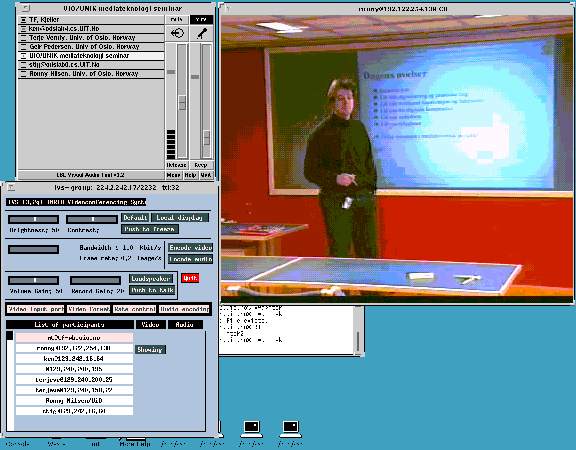
All the communication that takes place between the two classrooms is coded digitally and transmitted over the Supernet, a 34 Mbit/s IP network run by Norwegian Telecom.
In distance education, the video link attempts to substitute the "isochronous" lecture, but has no support for "asynchronous" communication that is also an important part of an educational environment. The asynchronous nature of announcements, handouts and copies of transparencies make them hard to transmit over a video link. Web servers, on the other hand, provide a long-distance asynchronous alternative.
In the experiment described in this paper, we augmented a video conferencing system with an hypertext archive. All lecture presentations and announcements were put into HTML and made available over the Web[3]. We had two main goals for this:
The University of Oslo has several campuses. Graduate students in computer science are either on the main campus (Blindern) or at a satellite campus one hour's travel away (Kjeller). Generally, classes do not overlap, and students are free to pick and choose from courses at both sites. Due to the geographical distance, however, most students only take advantage of the classes offered at one location. Therefore, the electronic distribution of courses is a stated goal and two electronic classrooms have been established to run experiments. This experimental setup will ideally turn into a facility that allows transparent distribution of courses.

Two electronic classrooms were used for the seminar [4][4]. They contain the equivalent of traditional two-way video conferencing systems as well as electronic whiteboards. All the communication that takes place between the two classrooms is coded digitally and transmitted over the Supernet.
The video system consists of two cameras (covering the lecturer and the audience) and a document camera. Video from the remote classroom is displayed on two monitors; one in the front of the room and one in the back. Each room is also equipped with a monitor showing the outgoing video signal. The video is transmitted digitally using a bandwidth of 300-800 Kbit/s with syncronized audio. The audio and video is coded according to the CCITT H.261 compression standard.

The application running on the whiteboard is a modified version of Mosaic for X11. The modifications, courtesy of Vinay Kumar of EIT [6], allows Mosaic clients to remote-control each other. As the lecturer moves forward in the sequence of slides, the corresponding URLs are being transmitted over multicast IP to the other clients which subsequently load the document. Note that this scheme does not scale well; as the number of remote clients grow, a single server will become overloaded.
Several constraints are encountered while using the modified Mosaic. It only sends URLs to the other clients when it retrieves a new document or is doing a reload. Functions like going back in history, scrolling and resizing of windows is not transmitted to the other clients. This makes sense -- the size of the screen, the preferred font and the history may vary between clients -- but turns out to be a constraint in this case.
The use of vat and ivs on ordinary workstations didn't turn out to be a success because of poor quality and reliability. But it proved to be a very interesting low-budget alternative compared to expensive classsrooms. Internet is likely to play an important role in the future of disance education due to existing infrastructure and low initial and running costs. In Norway there are around 40 video conferencing studios, but the number of machines connected to the Intenet is 40.000. These machines are not video conferencing studios, but they represent a huge potential for distance education.

Making the lecture transparencies electronically available has raised some questions with regard to the structuring of information. The sequential nature of a lecture and the corresponding slides do not exploit the capabilities of hyper-linked structures -- which users expect to find on the Web. The slides had to serve at least three different purposes:
2) for students not attending the lecture
3) for students attending the lecture wanting to review (parts of) the presentation later
[2] T. Kristiansen, Five years of research into the use of telecommunications in distance eduaction, Kjeller, Report from Norwegian Telecom Research, 1993
[3] http://www.nta.no/unik/mediateknologi.html
[4] K. Bringsrud, G. Pedersen, The MUNIN Project: Distributed Electronic Classrooms with Large Electronic Whiteboards, Proceedings of the IFIP TC3 International Conference: Teleteaching 93, Trondheim, Norway, 1993
[5] J.W. Bakke, B. Hestnes, H. Martinsen, Distance Education in the Electronic Classroom, Kjeller, Report from Norwegian Telecom Research, 1994
[6] http://www.eit.com/software/mosaic/sh-mosaic.html
[7] http://www.nta.no/telektronikk/4.93.html
He is also holding a position as a lecturer in Media Technology at the University of Oslo. Per Einar is a graduate from University of Manchester Institute of Science and Technology and Gjøvik Technical School.